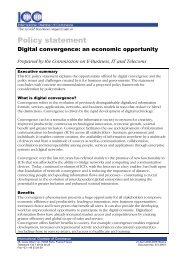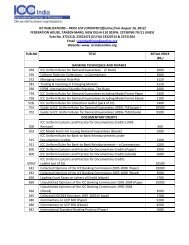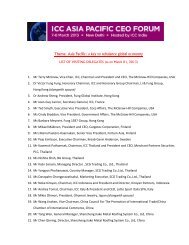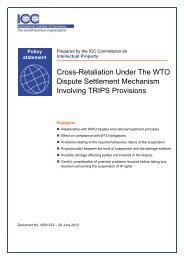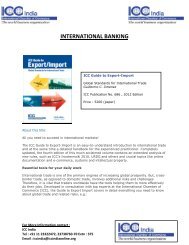2013 - ICC India
2013 - ICC India
2013 - ICC India
- No tags were found...
Create successful ePaper yourself
Turn your PDF publications into a flip-book with our unique Google optimized e-Paper software.
<strong>ICC</strong> BANKING COMMISSION | <strong>2013</strong> GLOBAL RISKS TRADE FINANCE | APPENDIX B 39To address this Basel II has tried to align risk weights more closely to theunderlying risk of the transaction based on external or bank estimatesof credit risk, while at the same time maintaining a prudent approach tosolvency assessment.Treatment of off balance sheet facilities with less than one-year maturity:Under the CCF rules, off balance sheet transactions with a contractualmaturity of less than one year had a 0% conversion factor.As a result, if an overdraft was set up with a contractual maturity of364 days, then the off balance sheet elements required no capital,irrespective of whether or not the facility was automatically rolled over/extended on day 365 56 .To counter this, Basel II requires banks to treat exposures based on theireffective maturity (reflecting the bank’s willingness and observed behaviourin extending such transactions) and placed a floor in most cases on thematurity of a transaction of one year, which impacts many trade financetransactions.Basel IIAs noted above, given some of the perceived shortcomings within the BaselI accord and improvements in banks’ internal risk measurement approaches,it was decided to replace Basel I with an approach which was more riskaligned. In 2004 the Basel II accord was approved 57 and the the committeemade clear that:“The fundamental objective of the Committee’s work to revise the 1988Accord has been to develop a framework that would further strengthenthe soundness and stability of the international banking system whilemaintaining sufficient consistency that capital adequacy regulation willnot be a significant source of competitive inequality among internationallyactive banks.” 58This new capital accord defined a new Framework based on three “pillars”:Pillar 1 – minimum capital requirements. Pillar 1 consists of a set ofapproaches and rules governing the assessment of the RWAs for credit,operational and market risk. The minimum capital requirement for a bankunder Basel II is then defined as 8% of the RWAs and at least half of thiscapital requirement must be covered by Tier 1 capital.Pillar 2 – supervisory review process. Under Pillar 2, banks assess theamount of capital that they would need using their own estimates andcovering risks, such as interest rate risk in the banking book that are notcovered or are poorly reflected by Pillar 1 estimates. Supervisors thenreview these figures and the risk and capital management of the bank.As a result of this internal assessment and the supervisory review process,the supervisor will indicate to the bank the level of capital they expect themto hold 59 .Pillar 3 – market discipline. Under Pillar 3, banks are required to publishdetails of their risk management approach as well as some more compositeinformation on the performance of their models and the breakdown of thecapital requirements. The intention of this was to allow the market to bettercompare risk across banks and “discipline” them through charging higherprices to riskier banks.



